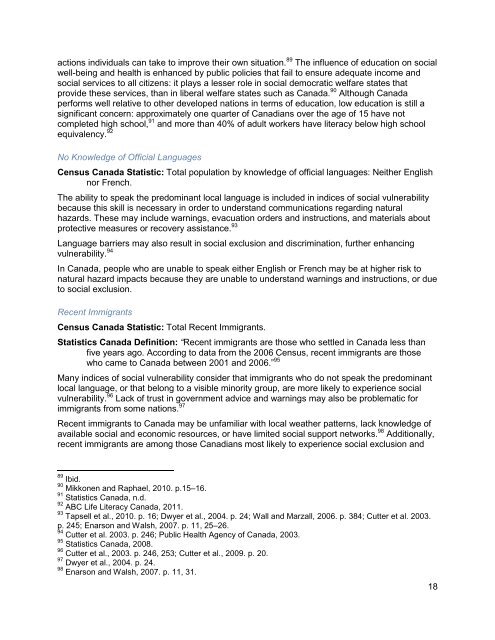Lunenburg Part 2 - Section 5 - Social Vulnerability - August 30.pdf
Lunenburg Part 2 - Section 5 - Social Vulnerability - August 30.pdf
Lunenburg Part 2 - Section 5 - Social Vulnerability - August 30.pdf
Create successful ePaper yourself
Turn your PDF publications into a flip-book with our unique Google optimized e-Paper software.
actions individuals can take to improve their own situation. 89 The influence of education on social<br />
well-being and health is enhanced by public policies that fail to ensure adequate income and<br />
social services to all citizens: it plays a lesser role in social democratic welfare states that<br />
provide these services, than in liberal welfare states such as Canada. 90 Although Canada<br />
performs well relative to other developed nations in terms of education, low education is still a<br />
significant concern: approximately one quarter of Canadians over the age of 15 have not<br />
completed high school, 91 and more than 40% of adult workers have literacy below high school<br />
equivalency. 92<br />
No Knowledge of Official Languages<br />
Census Canada Statistic: Total population by knowledge of official languages: Neither English<br />
nor French.<br />
The ability to speak the predominant local language is included in indices of social vulnerability<br />
because this skill is necessary in order to understand communications regarding natural<br />
hazards. These may include warnings, evacuation orders and instructions, and materials about<br />
protective measures or recovery assistance. 93<br />
Language barriers may also result in social exclusion and discrimination, further enhancing<br />
vulnerability. 94<br />
In Canada, people who are unable to speak either English or French may be at higher risk to<br />
natural hazard impacts because they are unable to understand warnings and instructions, or due<br />
to social exclusion.<br />
Recent Immigrants<br />
Census Canada Statistic: Total Recent Immigrants.<br />
Statistics Canada Definition: “Recent immigrants are those who settled in Canada less than<br />
five years ago. According to data from the 2006 Census, recent immigrants are those<br />
who came to Canada between 2001 and 2006.” 95<br />
Many indices of social vulnerability consider that immigrants who do not speak the predominant<br />
local language, or that belong to a visible minority group, are more likely to experience social<br />
vulnerability. 96 Lack of trust in government advice and warnings may also be problematic for<br />
immigrants from some nations. 97<br />
Recent immigrants to Canada may be unfamiliar with local weather patterns, lack knowledge of<br />
available social and economic resources, or have limited social support networks. 98 Additionally,<br />
recent immigrants are among those Canadians most likely to experience social exclusion and<br />
89 Ibid.<br />
90 Mikkonen and Raphael, 2010. p.15–16.<br />
91 Statistics Canada, n.d.<br />
92 ABC Life Literacy Canada, 2011.<br />
93 Tapsell et al., 2010. p. 16; Dwyer et al., 2004. p. 24; Wall and Marzall, 2006. p. 384; Cutter et al. 2003.<br />
p. 245; Enarson and Walsh, 2007. p. 11, 25–26.<br />
94 Cutter et al. 2003. p. 246; Public Health Agency of Canada, 2003.<br />
95 Statistics Canada, 2008.<br />
96 Cutter et al., 2003. p. 246, 253; Cutter et al., 2009. p. 20.<br />
97 Dwyer et al., 2004. p. 24.<br />
98 Enarson and Walsh, 2007. p. 11, 31.<br />
18














